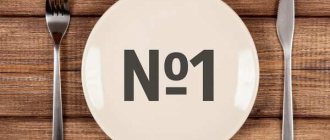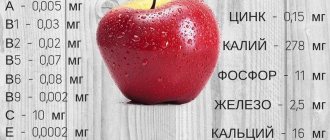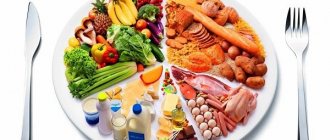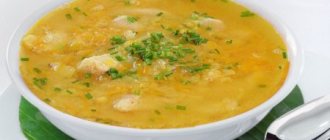General principles of diet for stomach ulcers
Knowing and adhering to the general principles of the diet that is used for stomach ulcers, you will be able to create your own menu as correctly as possible and not aggravate the course of the disease.
Among them are:
- Balance. You cannot deprive the patient of the calorie content of his meals. The daily menu should be balanced, and the energy value should be no less than 3000 kcal.
- Fractionality. Breaks between meals should not be more than three hours.
- Minimum portion size. Ideally, each portion of food should fit into cupped hands.
- Prohibition on fried and golden-brown foods.
- Prohibition of very hot or very cold food. Dishes that have a temperature above or below 30 °C inhibit the function of enzyme formation and slow down the process of restoration of epithelial tissue of the stomach. This rule is especially relevant at the time of exacerbation of a stomach ulcer.
- Refusal of products that increase gas formation.
- Complete refusal or minimizing the amount of salt consumed.
- Increasing the volume of water to 2 liters, in the absence of thyroid diseases and pathologies of the urinary system.
- Avoid carbonated drinks and alcohol.
- Refusal of any foods that increase the production of gastric juice.
- Heat treatment of dishes is allowed: stewing, boiling, steaming, blanching.
- Priority is given to gentle food that does not irritate the stomach wall.
- The principle of sparing. Mechanical stomach sparing involves selecting certain foods to eat at one time. Chemical sparing consists of eliminating foods that irritate digestive secretions.
- The principle of zigzag nutrition. He assumes that for short periods of time the patient is allowed to eat foods from the prohibited list (within reason), and then he is returned to the diet menu. This principle is intended to serve as a kind of training for the gastrointestinal tract and is used only at the recovery stage.
- The principle of individuality. That is, when creating a menu, you cannot be guided by the same principles for everyone. Much depends on what stage the disease is at, where the ulcer is located, what the patient’s age is, what his body weight is, whether there are concomitant diseases, etc.
- Calculation of food digestion time. So 200 ml of water, tea or broth will stay in the stomach for an average of 1.5 hours. After three hours, meat, boiled vegetables, apples and bread will leave it. Fatty fish, fried meat, and legumes last the longest there – up to 5 hours.
As for the timing, the diet must be followed for at least one year after an attack of exacerbation of the disease. The main goal of dietary nutrition in this case is to accelerate the regeneration of the mucous membrane lining the stomach and normalize the digestion process.
What should you not eat if you have a stomach ulcer?
All products that irritate the gastric mucosa, increase gas formation, take a long time to digest, or contain large amounts of salt are prohibited.
You should definitely avoid:
- Primary boiled meat and fish broths and prepared soups from them;
- Any dishes made from any mushrooms;
- Okroshka and cabbage soup;
- Any fatty meat and fish are prohibited, this also includes lard and caviar;
- Smoked products, most sausages (sometimes, during the recovery stage, you are allowed to eat a little boiled sausage or ham);
- Canned products, as well as pates;
- Dairy products with acid, for example, ayran, tan, etc. (Kefir is prohibited only during an exacerbation and +5 days after the attack has stopped);
- Fatty dairy products: buttermilk, condensed and whole milk, cream and cheeses;
- Hard-boiled eggs, as well as scrambled eggs (soft-boiled eggs are allowed);
- Among the cereal dishes prohibited are pearl barley, semolina porridge, wild rice and corn, as well as bran granules and muesli;
- It is worth limiting the consumption of cucumbers and tomatoes, as well as tomato paste;
- Products of plant origin that can irritate the mucous membrane of the damaged organ: sorrel and rhubarb, garlic and onions;
- Berries and fruits with acid: gooseberries, figs, grapes, currants, lemons, oranges, limes, tangerines, pineapples, etc.;
- Nuts, dried fruits and apricots are prohibited;
- Any hot, salty and spicy sauces: mustard, horseradish, ketchup, vinegar;
- Ice cream and chocolate;
- Strongly brewed drinks (strong tea, coffee);
- All carbonated drinks;
- Alcoholic drinks;
- Rye bread, pastries.
When processing meat products, cartilage and veins should be removed.
What can you eat if you have a stomach ulcer?
The list of foods that are allowed to be consumed for stomach ulcers is quite extensive, so the patient does not have to go hungry:
- Bread made from wheat flour. But it is important that it is not just baked. It’s better if a day has passed since it was made.
- Baking from unleavened dough (not yeast) in small quantities. The filling for such pies can be: fish, apples, cottage cheese or lean meat.
- Crackers, cookies, but not sweets, and biscuits are also allowed.
- Meat soups, but the most important rule when preparing them is the use of secondary broth. That is, after boiling, the broth is drained, the meat is again filled with clean water, and soup is prepared from this. As for the meat itself used to cook the soup, you can take either chicken or beef.
- Cereal soups without meat component.
- Cottage cheese, sour cream, yogurt, fermented baked milk. You can also eat cheese, but it is better to grind it. Preference should be given to unleavened cheeses.
- Main courses made from lean meat containing a minimum amount of veins. You can take rabbit, turkey, beef, chicken meat. As for the dishes themselves, the priority is zrazy, meatballs, cutlets, souffle, meatballs, but not fried. It's best to steam them.
- Fish, but not fatty varieties. An excellent solution is minced fish dishes. Only the fish needs to be boiled or steamed (can be in the oven, in foil)
- The patient needs to include eggs in his diet. You can cook an omelet from them, or boil them soft-boiled.
- Boiled cereals and pasta are useful. You can consume rice, rolled oats or buckwheat porridge (except semolina).
- Berries and fruits must first be peeled and ground until pureed. You can also bake apples and pears.
- As for desserts, you can diversify your own menu with marmalade, honey, marshmallows, marshmallows, jam, preserves. Jelly, mousse, jellies, and creams do not harm the damaged gastric mucosa.
- Suitable drinks include decoctions of rose hips and wheat bran, freshly pressed juices half diluted with water, loosely brewed teas, as well as compotes.
- You can consume olive and sunflower oil, unrefined, as well as unsalted butter in small quantities.
- White milk sauce can be used as a dressing for dishes.
Authorized Products
It is allowed to eat lean meats and fish.
For gastric and duodenal ulcers, it is recommended to eat:
- boiled chicken;
- low-fat beef meat;
- boiled fish;
- crackers without adding spices;
- juice from fresh cabbage and potatoes;
- vegetable puree soup;
- rosehip drink;
- avocado dishes;
- soft cottage cheese;
- non-sour fruits and berries;
- milk;
- some sweets (marshmallows, honey);
- flax and sea buckthorn oil.
Even some sweets that have an enveloping property, including jelly, mousse, and cream creams, have a positive effect on the mucous membrane of the stomach and duodenum. You can also sometimes eat a small amount of honey, marshmallows or jam without harm to your health.
What should you eat if you have a stomach ulcer?
List of foods that will help you speed up your recovery:
- Cauliflower
- White cabbage
- Radish
- Apples
- Blueberry
- Raspberries
- Blackberry
- Strawberry
- Cherry
- Bell pepper
- Carrot
- Leafy greens
- Liquorice
- Foods rich in probiotics, such as yogurt, kefir (kefir is prohibited during an exacerbation period)
High-fiber foods can prevent excess stomach acid secretion, which can reduce ulcer pain and protect the stomach lining as the ulcer heals.
Many high-fiber foods are also good sources of polyphenols, plant substances that have antioxidant, anti-inflammatory and protective properties that help improve healing.
Principles of nutrition during exacerbation of ulcers
When creating a menu for exacerbation of a stomach ulcer, you need to rely on the following principles:
- dishes should contain the maximum amount of nutrients;
- moderate temperature of food;
- maintaining a fractional diet with frequent meals.
It is important that a worsening stomach ulcer is treated with a proper diet. The patient needs to take meals with a temperature of no more than 50 degrees and no lower than 20. This temperature is the most favorable for good digestion of foods.
During the period of exacerbation, the patient’s body must receive all the necessary components and elements for a speedy recovery. First of all, the foods consumed must contain a sufficient amount of vitamins A, B and C, and then fats, carbohydrates, proteins and mineral salts. Nutrition for stomach ulcers during an exacerbation should be made so that the body receives no more than 100 grams of fat.
During an exacerbation of the disease, the patient must switch to a strict diet, which includes foods that help wounds heal. During this period, the patient needs to eat pureed first courses and soups, no irritating or harsh ingredients. After the exacerbation has subsided, the patient can gradually expand the list of dishes and switch to therapeutic nutrition.
Is it possible to eat, drink...?
It would seem that the list of permitted and prohibited foods for consumption with a stomach ulcer is quite clear. However, after visiting a doctor, most patients have a number of questions regarding one or another unspecified product.
Therefore, it is worth answering in more detail the most popular questions that arise among people suffering from ulcers:
- Is it possible to drink kefir, fermented baked milk, yogurt?
It is worth dealing with each of these fermented milk products separately. So kefir is prohibited during the period of exacerbation of the disease, as well as 5 days after the attack passes. After this time, you can consume kefir, but it is important that it is fresh and non-acidic. The main thing is to warm it slightly before using it internally. You can add a spoonful of vegetable oil to the drink, which will allow the existing ulcer to heal faster. Yogurt is one of the priority food products for the treatment of ulcers, since the bifidobacteria it contains have a detrimental effect on Helicobacter pylori. If possible, you should prepare this product yourself, at home. As for fermented baked milk, it is also allowed for this stomach pathology. However, it is worth buying this fermented milk product with minimal fat content.
- Is it possible to eat cucumbers and tomatoes?
When the disease is in the acute stage, vegetables such as cucumbers are prohibited for consumption. After the remission stage has begun, you can gradually include them in the diet, but in small quantities and without the skin. This vegetable is added to salads in various forms, but it is best to grate it. Tomatoes, as well as cucumbers, are prohibited during an exacerbation of the disease. This is due to the fact that they help reduce the rate of ulcer healing and slightly increase the acidity of gastric juice. When the exacerbation of the disease has been eliminated, you can use tomato fruits in the daily menu, but first douse them with boiling water and remove the skin.
- Can you eat banana?
Bananas are allowed for consumption by patients with gastric ulcers. Once in its cavity, they envelop the organ, thereby reducing the acidity of gastric juice. This helps eliminate pain and speed up healing of the existing ulcer. In addition, bananas have increased nutritional value.
- Is it possible to have cheese or cottage cheese?
Cottage cheese is a product that must be on the table of a patient with a stomach ulcer. It does not contain anything that could provoke an attack of the disease or aggravate the patient’s condition. In fact, cottage cheese is coagulated milk protein, without whey, which is endowed with vitamins B, PP, A, and iron. Therefore, it has undoubted value for sick people. Moreover, cottage cheese can be purchased both in the store and prepared at home. The product can be used to prepare many dishes: casseroles, soufflés, mousses, creams, etc. It is worth choosing cottage cheese that has a low fat content. Cheese is also a valuable product in the diet of a person with an ulcer. It contains a lot of easily digestible protein and amino acids, as well as calcium. The main thing is to give preference to cheeses that have low fat content and low salt content.
- Can I have eggs?
Eggs are among those products that have high nutritional properties and provide an excellent opportunity to compensate for the lack of vitamin A, B6, B2, E, phosphorus, calcium, cobalt, glands and other trace elements in the diet. The protein that makes up the egg is perfectly absorbed by the human body, but it is important to prepare it correctly. You should not boil or fry eggs for a long time; patients with ulcers are advised to consume this product soft-boiled or in the form of an omelet. A raw egg will be useful, but in this case the risk of salmonellosis infection increases.
- Can I have watermelon?
Patients with stomach ulcers are prohibited from eating watermelon. This is due to the fact that it causes increased secretion of gastric juice, increases its acidity, which will contribute to the exacerbation of the disease. During the period of remission, you can include a small amount of fresh watermelon in your menu, but you should not do this on an empty stomach.
- Can I have seeds?
Seeds are prohibited for stomach ulcers, as they irritate the mucous membrane, can further injure it and aggravate the pathological process. In addition, they contain difficult-to-digest fats, which negatively affect the course of the disease. After the seeds enter the stomach of a person with an ulcer, he will begin to experience pain as the acidity level increases, flatulence and complications from the gallbladder are often observed. You should not consume seeds even during remission, as this may exacerbate the ulcerative process.
- Can I have garlic?
During the period of exacerbation of the disease, a product such as garlic is strictly prohibited. When the patient's condition reaches stable remission, it is allowed to be eaten. However, patients with a history of ulcers should first steam the garlic, or add it to pureed dishes: mashed potatoes, boiled cereals, etc. You can add it in very small quantities when stewing or boiling dishes, to give them some pungency and smell .
- Can I have coffee?
During an exacerbation of the disease, any coffee drink is prohibited. You should not consume either natural or instant coffee. When the disease is in remission, you can sometimes add a small cup of natural coffee to your menu, provided that it is not strongly brewed. However, remember that the reason to avoid this tonic if you have a peptic ulcer is that it affects the production of hydrochloric acid, increasing its production. This, in turn, affects the development of the disease, provoking its exacerbation.
- Can I drink soda?
For heartburn and belching, many people use soda to relieve unpleasant symptoms. This substance can actually have a neutralizing effect on hydrochloric acid, which is formed in excess during stomach diseases. However, after a very short time, when the soda leaves the organ and moves into the duodenum, the body will release a new portion of acid, but in even larger quantities. In addition, the interaction of acid and soda promotes the release of carbon dioxide, which, in turn, puts pressure on the walls of the stomach. There is an increased risk of perforation in the area where the ulcer is present. Therefore, drinking soda with this pathology is strictly prohibited.
- Is it possible to smoke?
Smoking and stomach ulcers are two incompatible concepts. Firstly, tobacco smoke provokes the development of this pathology and has an unnecessary stimulating effect on the entire gastrointestinal tract. Secondly, getting into the stomach with swallowed saliva, nicotine increases existing inflammation, inhibits regeneration processes, and prevents the ulcer from scarring. Thirdly, according to the latest data, smokers die from stomach ulcers 5 times more often than non-smokers with a similar disease. In addition, tobacco smoke provokes an increase in symptoms of the disease, in particular heartburn, belching and pain. Therefore, it is necessary to give up this bad habit, especially if an ulcer has been diagnosed.
- Can I have vodka or cognac?
Gastroenterologists clearly agree that drinking alcohol if you have a stomach ulcer is strictly prohibited. This is justified by the fact that any alcohol, including vodka and cognac, provokes inflammation of the walls of the stomach, increases the acidity of its juice, and slows down the process of digestion of food. All this, in turn, leads to an exacerbation of the pathological process and can even cause gastric bleeding. If it is not possible to abstain from drinking alcohol, then in small quantities and not during an exacerbation of the disease, you should give preference to strong but high-quality drinks, preferably vodka. In this case, it is necessary to have a hearty lunch first, but the food should be gentle and envelop the stomach. In this way, it will be possible to protect its walls to some extent from the harmful effects of alcohol.
The benefits of milk for stomach ulcers are a myth!
For many years, people with peptic ulcers have been advised to drink plenty of milk as it soothes the stomach and helps heal the ulcer. However, this is not quite true. Milk may help for a few minutes while it coats the stomach. But milk is a powerful product that stimulates the production of hydrochloric acid, which aggravates the course of the disease.
There is a study in which 60 patients with stomach ulcers took part. One group was on a regular classic diet, the experimental group received 500 ml. milk for breakfast, 750 ml. for lunch and the same amount for dinner (in addition to basic treatment). As a result, in the group that was on a classic diet, 78% of patients were cured of stomach ulcers - this is the usual norm for hospital treatment. However, in the experimental group that drank milk, only 53% were cured. [12].
From this we can conclude that it is not advisable to drink whole milk during treatment.
Menu for a week for stomach ulcers
It is important to remember that during an exacerbation of the disease, you should adhere to a special diet, which is called table No. 1. Subsequently, when the attack is eliminated, you can switch to a more varied diet.
Monday
- You can start the day with a couple of soft-boiled chicken eggs and buckwheat porridge in the amount of 250 g. The drink used is weak tea.
- For second breakfast, you can use a baked apple, which you can wash down with a glass of low-fat yogurt.
- For lunch, a patient with a stomach ulcer is offered chicken soup with boiled rice. For the second course you can prepare mashed potatoes with beef meatballs. Fruit jelly is suitable as a dessert. The drink used is rosehip decoction.
- The afternoon snack should consist of green tea and a couple of crackers.
- For dinner, you can steam pike perch and complement it with cabbage inflorescences, also cooked in a double boiler. You can use weak tea as a drink.
- You can end your day with green tea or yogurt.
Tuesday
- For breakfast, you can use egg porridge, which is prepared using 2 eggs, milk and butter. You can wash it down with strawberry jelly.
- As a second breakfast, the patient can be offered buckwheat porridge with milk. The drink used is weak tea.
- For lunch, a person is served pureed zucchini soup. The second course consists of an appetizer of fish pate (any lean fish), as well as a casserole of potatoes and beef, cooked in foil, with sauerkraut. Apple mousse can be used as a dessert.
- In the afternoon you can eat a banana and wash it down with slightly warmed fresh kefir.
- Dinner includes jellied chicken meatballs and mashed potatoes. As a dessert, sour cream spread on stale bread is used. You can drink it with weak tea.
- Drink green tea or yogurt before bed.
Wednesday
- For breakfast, you can prepare pureed rice porridge with milk and wash it down with apple compote. Second breakfast can consist of cottage cheese and oatmeal jelly.
- For lunch you can serve noodle soup cooked in vegetable broth. Beetroot salad with vegetable oil is acceptable as an appetizer. For the main course, you can use crumbly buckwheat porridge with herbs and Polish-style pike perch with sauerkraut. You can drink it with weak black tea.
- At midday, the patient is served biscuit crackers and a glass of low-fat yogurt.
- Dinner consists of pilaf with boiled beef, vegetable risotto and vitamin jelly. You can make apple nests as a dessert.
- End your Wednesday day with green tea and fruit jelly.
Thursday
- For breakfast, you can offer a sweet mucous decoction of pearl barley with milk and yolk, crackers and milk jelly with carrots.
- Snowballs and warm, weak tea are used as a snack.
- For lunch, rice soup with pumpkin is prepared; as a second course, you can serve rabbit meat soufflé and boiled pasta with sauerkraut. For dessert, apples and pears in syrup are used, which can be washed down with grape jelly.
- Dinner for a patient with an ulcer consists of beet and potato salad, pumpkin-squash puree, and jellied turkey. Green tea.
- As a snack before a night's rest, you can use curd pudding with apples and a glass of fermented baked milk.
Friday
- For breakfast, prepare buckwheat porridge with jam. Tea is used as a drink.
- As a snack, you can offer lazy dumplings with cottage cheese and a strawberry smoothie.
- For lunch, the patient is offered a green salad with sour cream, soup with dill and dumplings, and as a second course - zucchini stuffed with meat and sauerkraut.
- In the afternoon you can eat a fruit salad and wash it down with strawberry jelly.
- For dinner, the patient is served boiled tongue with mashed potatoes and pudding made from rolled oats and apples. You can drink it with weak black tea.
- The evening ends with green tea or yogurt.
Saturday
- Breakfast can consist of milk soup with boiled noodles and warm tea.
- The second breakfast consists of a glass of fermented baked milk and beet puree.
- For lunch you can eat apple soup with prunes and herring soaked with vegetables. Dessert – sponge cake with squirrels
- For an afternoon snack, the patient can indulge in a cocktail of kefir and strawberries with apple pudding.
- For dinner on Saturday you can have baked cod and barley crumbly porridge and sauerkraut. You can complement your evening meal with a dessert of jelly with fruit.
- Green tea with crackers is used as an evening snack before bed.
Sunday
- You can start your morning with boiled noodles with cheese and butter and weak tea.
- You can have a snack before lunch with cottage cheese and potato casserole and vitamin jelly.
- For lunch, boiled potatoes or mashed potatoes are used, and boiled meat with sauerkraut, as well as cauliflower soup and cheese mixture with carrots. The drink used is pureed apple compote.
- As an afternoon snack, you can offer an apple baked with honey.
- For dinner we use homemade kefir, beef stroganoff with soybean oil and boiled beef, supplemented with mashed potatoes. You can wash it down with berry compote.
- As a snack before bed, you can drink green tea and eat one soft-boiled egg.
Weekly diet for an ulcer patient
The diet for stomach ulcers during an exacerbation is compiled taking into account the stage of the disease. Most of the diet should be represented by cereals, vegetables, lean meat or fish. Following the recommended menu allows you to improve your well-being within a week. After this, the specialist adjusts the diet and drug therapy.
The dietary menu for stomach ulcers during an exacerbation is as follows.
For breakfast:
- choice - 2 soft-boiled eggs/milk porridge/omelet;
- weak green tea;
- cottage cheese with 1 tsp. honey
For second breakfast: apricot, peach or banana puree with a small amount of milk.
For lunch:
- vegetable puree soup with croutons;
- boiled fish or chicken/steamed cutlets;
- mashed potatoes/rice;
- salad of boiled beets and carrots;
- compote.
For afternoon tea:
- cottage cheese casserole with raisins/baked apple with honey;
- rosehip/chamomile decoction.
For dinner: chicken or fish/cottage cheese casserole/soup.
For a snack: warm milk with honey or kefir - 1 glass.
A strict diet for exacerbation of an ulcer lasts 1-2 weeks, after which a specialist prepares a diet for the coming months. The diet will not be so strict, but alcohol, fatty meat and fish, coffee, smoked meats, marinades, pickles, carbonated drinks, and baked goods are still prohibited.
Monday
The menu includes the following:
| Breakfast | Lunch | Dinner | Afternoon snack | Dinner | Second dinner |
| Rice porridge with milk, soft-boiled eggs, weak black tea with milk | Cottage cheese with sour cream and fruit | Beetroot, boiled vegetables with white fish, rosehip infusion | Kissel with biscuits | Minced chicken meatballs, baked potatoes, tea with crackers | Milk with honey |
Tuesday
The menu includes:
| Milk soup, with noodles, rosehip broth | Carrot salad | Vegetable puree soup, baked chicken, mashed potatoes, compote | Fruit or berry puree | Pollock baked in foil, vegetable stew, green tea | Yogurt, croutons |
Wednesday
Menu composition:
| Semolina porridge with milk with added water, non-acidic cottage cheese, tea, biscuit | Apple casserole | Vegetable soup with semolina, steam cutlets, buckwheat porridge, jelly, bread | Compote with biscuits | Baked minced fish cutlets, pumpkin and green pea puree with vegetable oil, oatmeal with water, tea with honey, bread | Milk |
Thursday
On this day of the week we offer:
| Buckwheat porridge with milk, non-sour cottage cheese, herbal tea | Fruit jelly, dry cookies | Oatmeal soup with meatballs, rice porridge, well boiled, steamed cod meatballs, bread, compote | Rose hip decoction, cookies | Boiled chicken, minced into mince, potato and zucchini puree, pear and apple broth | Kefir |
Friday
If a stomach ulcer is diagnosed, the composition of the dishes is as follows:
| Cottage cheese with sour cream and honey, chamomile decoction | Cookies, plum juice | Rice soup with vegetables and vegetable oil, veal cutlets, buckwheat porridge, bread, jelly | Rosehip infusion, biscuit | Steamed fish, vegetable puree, bread, tea | Milk |
Saturday
Menu for the day:
| A few soft-boiled eggs, crackers, black or green tea | Fruit puree with sour cream and cottage cheese, rosehip infusion. | Pearl barley soup, steamed chicken cutlets, boiled cauliflower, compote | Curd casserole with berries | Beet salad, fish meatballs, buckwheat porridge, jelly | Milk with honey |
Sunday
The daily menu includes:
| Oatmeal with milk and butter, sweet cottage cheese, tea with milk, cookies | Fruit jelly, sponge cake | Potato soup with butter, boiled veal, pumpkin and carrot puree with butter, jelly, bread | Fruit or rice pudding, herbal decoction. | Hake baked in milk sauce, buckwheat porridge, tea | Ryazhenka |
Recipes for stomach ulcers
There are many recipes for dishes that can be prepared for a patient with a stomach ulcer.
Many of them are quite simple, but there are also some that can be a little complex:
- Pike perch in Polish.
In order to cook pike perch in Polish, the fish will need to be cleaned, washed and boiled with the addition of 1 carrot and 1 bunch of parsley. An oil-egg sauce is used as a sauce, which is placed on a side dish: buckwheat, rice or boiled mashed potatoes.
- Risotto.
To prepare dietary risotto for a patient with a stomach ulcer, you will need to peel the carrots, celery root and parsley and lightly simmer them in a small amount of water. Rice in the amount of 4 tablespoons is boiled in slightly salted water, then mixed with vegetables and transferred to a form greased with sunflower oil, poured with milk and egg and baked in the oven.
- Recipe for diet snowballs.
To prepare them, you will need to take a couple of eggs, about half a glass of pasteurized low-fat milk, a little flour and three tablespoons of powdered sugar. The whites are separated from the yolks and beaten, and powdered sugar is added. Dip the whites into boiling milk with a spoon and cook, but no more than 5 minutes. Then the sauce is prepared. To do this, the yolks are mixed with powdered sugar and hot milk and boiled in a water bath. The resulting sauce is poured into protein snowballs and served.
- Turkey aspic.
In order to prepare turkey aspic, the meat must first be boiled and cooled, the skin removed and cut into small slices. While the carrots are boiling, you can prepare the jelly by filling it with water 1 to 8 (for half an hour). Then jelly and salt are added to the boiling carrot broth, after which the mass is filtered. Parsley and dill are cut coarsely and poured into the gelatin mass along with turkey and chopped boiled carrots. All this is put into the refrigerator to harden.
Recipes for some dishes for ulcer patients
Vegetable soup with rice
The cereals are boiled separately for it. Add peeled whole vegetables to boiling water and cook for about half an hour. Boiled rice is added to the resulting mass, salted and dill is added. Ingredient proportions:
- carrot - 1 pc.;
- rice cereal - 2 tablespoons;
- medium onion - 1 pc.;
- dill - to taste;
- potatoes - 2 pcs.
Beef balls
The dish is steamed.
The meat is freed from skin and veins, boiled and ground. Boiled rice groats along with the resulting minced meat are once again passed through a meat grinder, salt to taste and an egg are added. The balls are steamed. For preparation use the following ingredients (in grams):
- meat - 110;
- rice - 12;
- water - ½ cup;
- chicken egg - 1 pc.;
- butter - 5.
Semolina porridge with honey
Cook for 7 to 10 minutes in water. Then add milk and cook for the same amount of time. After this, add butter and honey to the porridge. Ingredient proportions:
- semolina - 3 tablespoons;
- milk - ½ cup;
- butter - 1 teaspoon;
- water - 1 glass.











